Zebra Finch - Finch Species
Articles and Information
 Normal Pair of Zebra Finches Normal Pair of Zebra Finches
Name: Zebra Finch (Taeniopygia guttata)
Origin: Australia
Habitat: Grass Lands, Forest Edge
Sexing: Common Grey: Males display orange cheeks, black breast bars, brown and white flanks, & a deeper red beak color than the females.
Breeding: Easy - Article: Breeding Zebra Finches
Social: Yes, Good cage and Aviary birds, compatible with many other finch species.
Mutations: Yes, 30+ color mutations and 4 size mutations known throughout the world.
|
Color Mutation variations
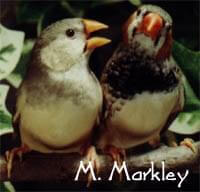 Myra Markely (FinchNiche) photo of Black Breast Zebra Finch
Black Breast Zebra Finch Myra Markely (FinchNiche) photo of Black Breast Zebra Finch
Black Breast Zebra Finch
Black Breast is just what it sounds like, a Zebra with a very black breast.
Identification Markings:
Males - Chestnut colored flanks speckled with elongated white spots. Orange Cheek Patches which are considerably larger than that of Greys, these cheeks may extend to the top of the head.. Black breast bar is very solid and wider than normal.. Zebra Stripes on the chin & neck. Red / Dark Orange beak. Totally lacking the black tear marking.
Females - Same base color of the males but lack all the extra colorful plumage. Beaks are also a lighter color, more orange. Also totally lacking the black tear marking.
Genetics: This is a recessive trait. Birds may carry the Black Breast gene and not show it until they are bred with another Black Breast or a bird which is split to it. |
|
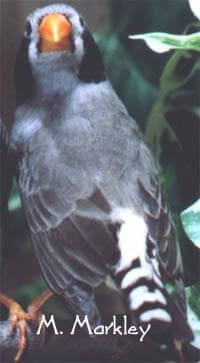 Myra Markley (FinchNiche) photo of Black Cheek Zebra Finch
Black Cheek Zebra Finch Myra Markley (FinchNiche) photo of Black Cheek Zebra Finch
Black Cheek Zebra Finch
Black Cheeks are becoming very popular because they are so easy to recognize.
Identification Markings:
Males - Chestnut to black colored flanks with white dots. Very black cheek patches. Black breast bar is normal. The black tear marking is blended in with the Black Cheek look.
Females - Same base color of the males plus the bold black cheeks. This makes the females very striking looking.
Genetics: This is a recessive trait. Birds may carry the Black Cheek gene and not show it until they are bred with another Black Cheek or a bird which is split to it. Please note, breeding a full Black Cheek to another full Black cheek is strongly not recommended |
|
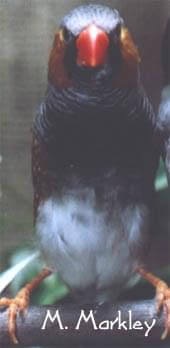 Myra Markely (FinchNiche) photo of Black Face Zebra Finch
Black Face Zebra Finch Myra Markely (FinchNiche) photo of Black Face Zebra Finch
Black Face Zebra Finch
Black Face have black coloration from the side of their beak to the tear drop markings giving them the Black Face look.
Identification Markings:
Males - Chestnut to reddish colored flanks are usually missing the white dots all together. Orange Cheek Patches. Black breast bar is very solid and may extend from the chin to the below the breast. The black tear marking is blended in with the Black Face look.
Females - Same base color of the males but lack all the extra colorful plumage. Females may also have the Black Face look but it's more subtle and may appear as a light grey.
Genetics: This is a dominant trait. Only one parent is needed and recommenced to produce Black Face offspring. |
|
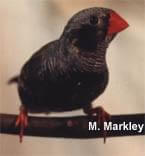 Myra Markely (FinchNiche) photo of Black Face/Black Cheek Zebra
Black Face Black Cheek Zebra Finch Myra Markely (FinchNiche) photo of Black Face/Black Cheek Zebra
Black Face Black Cheek Zebra Finch
Uncommon to Rare. They aren't any more difficult to breed than nay other zebra finch but to get the desired combination takes time.
Identification Markings:
Males - Will have the Black Face & Black Cheek mutations markings. It's best to have Black Flanks with white dots but so far all mine have has mostly brown flanks. The Breasts should be solid black and extend down to the abdomen.
Females - Will also have the Black Face and Black Cheek look. No flank markings are prefered, Breast marks are tolerated.
Genetics: This is a combination of mutations. Breed a BF split to BC to a full BC to produce Black Face Black Cheeks. |
|
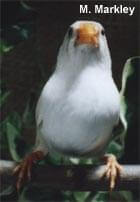 Myra Markely (FinchNiche) photo of Chestnut Flanked White Zebra
Chestnut Flanked White Zebra Finch Myra Markely (FinchNiche) photo of Chestnut Flanked White Zebra
Chestnut Flanked White Zebra Finch
As the name suggests, both sexes should have a pure white body color.
Identification Markings:
Males - Males should have all the typical males markings, cheeks, flanks, breast, etc.. Only the colors should be a more pale tone which give the bird a soft color look.
Females - Females should only have the black tear marks, the rest of the body should be pure white as the males. Some females will have a dusky or greyish colored head.
Genetics: This is a sex-linked trait. Females either are or are not Chestnut Flanked White, males can carry the gene. Which is why I produce female Chestnut Flanked Whites. |
|
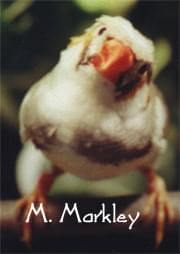 Myra Markely (FinchNiche) photo of Crested Pied Zebra
Crested Zebra Finch Myra Markely (FinchNiche) photo of Crested Pied Zebra
Crested Zebra Finch
Crested zebras have a little rosette of feathers on top their heads.. Very cute in my opinion. The crest is either a full circle, a semi-circle, or a few feathers standing upright. I refer to the birds with upright feathers as my "bad hair cut bird". The flat and fully circular look is what is preferred among breeders.
Identification Markings:
Males - They have all the normal markings of whichever color mutation they happen to be. The Crested look can appear on any color.
Females - Females are also the same in appearance and also have the crest.
Genetics: This is a dominant trait. Only one parent is needed and recommenced to produce Crested offspring. Unlike other species with a Crested mutation, pairing two crested zebras together will not result in baldness. |
|
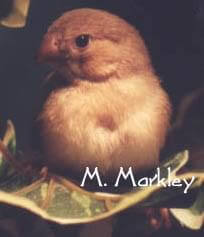 Myra Markely (FinchNiche) photo of Fawn Zebra Finch
Fawn Zebra Finch Myra Markely (FinchNiche) photo of Fawn Zebra Finch
Fawn Zebra Finch
Fawn is another color I don't actually breed for, they just pop up, mostly as females. They are very pretty, and I enjoy the color, but it's not something I plan to specifically breed for. (pictured is a juvenile fawn, not adult.)
Identification Markings:
Males - Over all rich brown body color. Brown to reddish flanks with white dots. Orange cheek patches. Black breast bar and tear marks.
Females - Females carry the typical female markings and the body color is the same as the males.
Genetics: This is a sex-linked trait. Females either are or are not fawn, males can carry the gene. Which is why I produce female fawns. |
|
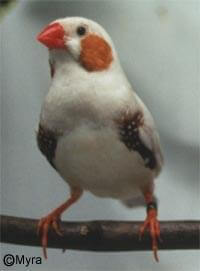 Myra Markely (FinchNiche) photo of Florida Fancy Zebra Finch
Florida Fancy Zebra Finch Myra Markely (FinchNiche) photo of Florida Fancy Zebra Finch
Florida Fancy Zebra Finch
Some say Florida Fancy and Isabel are one in the same. I am not one of those people, but I admit they do look a lot alike.
Florida Fancy lack black markings yet retain their bright orange/red colors. While they have no tear mark, breast markings, or neck barring they often do have very faint tail bars. These bars will show up as a very light grey to silver color and be almost not noticeable in the best colored birds. Bodies on both sexes should be white.
Identification Markings:
Males - Show bright orange cheeks. Reddish brown flanks dotted with white. These normal zebra male markings should be visible and bright. No black markings.
Females - Should be entirely white. No tear marks, but like the males they usually have very faint tail bars.
Genetics: Co-Dominant trait. Not really behaving as a dominant trait all the time. |
|
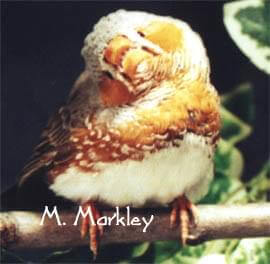 Myra Markely (FinchNiche) photo of Orange Breast Zebra Finch
Orange Breast Zebra Finch Myra Markely (FinchNiche) photo of Orange Breast Zebra Finch
Orange Breast Zebra Finch
Orange Breast are very neat looking zebras to someone who spends most of her time looking at black breasts, pieds, and greys with the very black breast markings. I do breed orange breasts but only because I find them interesting and I do admit my line isn't perfect, I haven't achieved the full orange breast color yet.
Identification Markings:
Males - Chestnut to reddish colored flanks with white dots. Orange cheek patches. Black breast bar is orange, in fact all Black pigment should be replaced with orange.. They do have all the normal male markings.
Females - Same base color of the males tho they will show orange on the tail coverts as do the males.
Genetics: This is a recessive trait. Birds may carry the Orange Breast gene and not show it until they are bred with another Orange Breast or a bird which is split to it. |
|
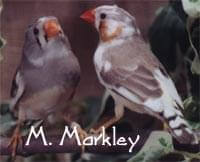 Myra Markely (FinchNiche) photo of Pied Zebra Finch
Pied Zebra Finch Myra Markely (FinchNiche) photo of Pied Zebra Finch
Pied Zebra Finch
Pied refers to white markings where you would normally have color. No two pieds are identical.
Identification Markings:
Males - Chestnut colored flanks speckled with white. Orange Cheek Patches. Black breast bar. Zebra Stripes on the chin & neck. Red / Dark Orange beak. Random areas will show pied
Females - Same base color of the males but lack all the extra colorful plumage. Beaks are also a lighter color, more orange. Random areas will show pied
Types of Pied: I consider there to be 3 types of pied. Light, Medium, and Heavy.
- Light Pied - These pieds show only a little of the white markings. Usually a few flight feathers, a small patch under the beak and/or on the head.
- Medium Pied - These birds will show more pied. It's an almost even 50/50 spit, in the areas that should show color half will be white. Usually many tail feathers, a large area on the head and in males they may only partly show the more colorful feathers.
- Heavy Pied - They look mostly white. I don't consider a finch to be a heavy pied unless at least 70% of the body is white.
Genetics: This is a recessive trait. Birds may carry the Pied gene and not show it until they are bred with another pied or a bird which is split to pied. |
|
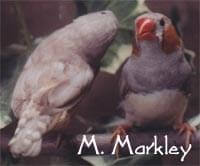 Myra Markely (FinchNiche) photo of Recessive Silver Zebra Finch
Recessive Silver Zebra Finch Myra Markely (FinchNiche) photo of Recessive Silver Zebra Finch
Recessive Silver Zebra Finch
Recessive Silvers are alot like greys, except for the fact their main body coloring is a very light to silver.
Identification Markings:
Males - Chestnut to reddish colored flanks with white dots. Orange cheek patches. Black breast bar should be black but is often more dilute, appearing grey or dark silver.
Females - Same base color of the males and yes, still lacking all the extra male colors. Both sexes will have tear markings.
Genetics: This is a recessive trait. Birds may carry the Recessive Silver gene and not show it until they are bred with another Recessive Silver or a bird which is split to it. |
|
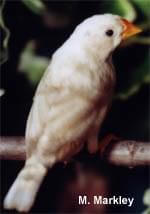 Myra Markely (FinchNiche) photo of Silver Isabel Zebra Finch
Silver Isabel Zebra Finch Myra Markely (FinchNiche) photo of Silver Isabel Zebra Finch
Silver Isabel Zebra Finch
Very pretty birds. Isabel is more of a patterns of colors. The isabel look is also known as the 'pearling' look. The colors (usually light grey body) are broken up with lighter patches of color. It almost makes the bird look iridescent.
Genetics: Co-Dominant trait. I have only 1 Silver Isabel breeder whom is paired with a Grey hen, they produce mostly Silver Isabel females, a few males, and some greys of both sexes. |
|
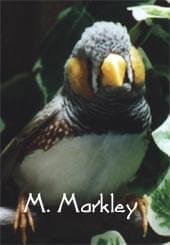 Myra Markely (FinchNiche) photo of Yellow Beak Zebra Finch
Yellow Beak Zebra Finch Myra Markely (FinchNiche) photo of Yellow Beak Zebra Finch
Yellow Beak Zebra Finch
Yellow beaks will have a yellow to pale orange beak color. The more yellow the better though. I don't actually breed for Yellow Beak. The mutation keeps popping up now and then.
Identification Markings:
Males - They have all the normal markings of whichever color mutation they happen to be. The Yellow Beak look can appear on any color.
Females - Females are also the same in appearance and also have the Yellow Beak.
Genetics: This is a recessive trait. Birds may carry the Yellow Beak gene and not show it until they are bred with another Yellow Beak or a bird which is split to it. |